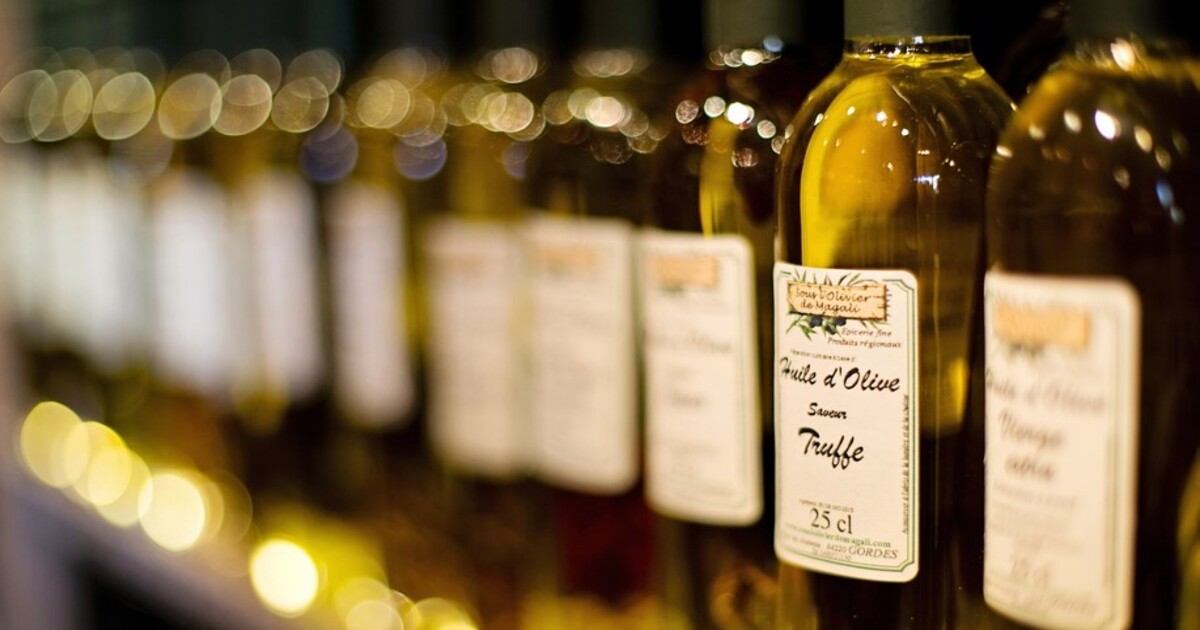Sowing the Seeds of Food Fear
The controversy of “the hateful eight” of seed oils. Plus: A recipe for walnut, olive or other oil cake.
August 31, 2024

Which of these oils do you have a bottle of within reach of your stove: Canola, corn, sunflower, safflower, grapeseed, cottonseed, soybean and rice bran oils?
Across the Atlantic and the internet, these oils have been dubbed “The Hateful Eight.”
Me, I have two of them. According to concerned cooking friends in the United States, I should pour them away. (Not down the sink — I almost had to have my kitchen wall dismantled to get at a fat berg that had accumulated in the water pipe over the years of letting my house out while I was posted overseas).
“Scientific” food fads
You never know with scientific “discoveries.” One year, butter was the focus of dread by those who followed Food & Drug Administration health warnings. From one day to the next, man-made margarine was elevated to the healthy-choice fat.
Then, just as we had stocked our fridges with brands given names like ‘I Can’t Believe It’s Not Butter!’ which my family shortened to “Snot Butter,” we were informed these were stuffed with evil trans fats and we should immediately migrate back to the purity of butter from animals that wouldn’t know what a trans-fat was if it bit them in the udder.
Salt was the next fall guy. There was some herbal mixture that promised to deliver the same saline qualities healthily from a bunch of ground-up herbs and twigs that wouldn’t harden our arteries nor raise our blood pressure but so insipid in flavor it needed applying in ferociously copious quantities.
No sooner had we dumped our treasured and pricey Maldon, our Sel de Guérande and other recherché cooking and finishing salts in favor of products called Mother something, and Forti, and Unpretentious and further dismal names, than we were informed that salt supports essential medical requirements (which you can jump the next paragraph to skip):
The necessary balance of electrolytes and fluids, the carriage of nutrients into our cells, the regulation of acid-base balance, the support transfer of nerve impulses, the regulation of blood pressure and the secretion of gastric acid. Next patient, nurse, please.
Grapeseed oil in the crosshairs
Taking high price as an indication of the value of a product, I assumed the expensive and reputed enhanced healthiness of grapeseed oil was going to take me well past my 100th birthday (sorry, kids).
Its health claim is due to grapeseed oil’s high amounts of polyunsaturated fat and its vitamin E, which lower blood cholesterol levels and reduce risk of heart disease. Plus, the oil gets rid of a useless byproduct of the wine-making industry.
In cooking, grapeseed oil was touted for its high smoking point — 220C/425F, roughly the temperature of a pan placed over medium-high heat — that meant food would crisp up without the oil burning. Which also meant it wouldn’t release toxic fumes or harmful free radicals.
Well, apparently no longer. TikTok health gurus, self-styled and otherwise, now claim that grapeseed and the other seed oils are toxic, causing everything from acne and cancer to infertility and weight gain. In for a penny, in for a pound or kilo, I suppose.
A little history
Seed oils came to prominence in the late 1900s as an alternative to the demons of those days, partially hydrogenated oils, which are created when hydrogen is added to vegetable oil in a process aimed to increase the shelf-life and stabilize the flavor of processed food over a very extended period.
Even if you own none of those oils, we are now encouraged by social media platforms to consider corrupt, they appear in a vast range of packaged foods, from confectionery to baked goods, ready-meals, snacks and condiments.
20% of the average European’s calorie intact is from seed oils, though this quantity is about a third less than that of the average American.
Given these are oils that did not exist in our diets before the 20th century, they represent a huge increase in the consumption of polyunsaturated Omega-6 fats.
What is wrong with that? Are Omega-6 fatty acids not essential to the nervous system, our hair, skin and bones? Yes indeed. But only as 1-2% of our daily calorie intake, not 20% or more.
The Seed Oil Free Alliance
Corey Nelson of the Seed Oil Free Alliance, which also includes peanut and flaxseed oils in its Harmful Seed Oils list, says, “We take the position that seed oils are entirely unnecessary as part of a healthy diet and that research suggests there are significant risks associated with current high intake levels,” such as heart disease, weight gain, chronic inflammation and some cancers.
This is disputed in the way these things can be, by scientists with no skin in the game, including cardiologist and professor of nutrition, Dariush Mozaffarian, at Tufts University Friedman School of Nutrition Science and Policy, who says the evidence is “incorrect or incomplete.”
A 2019 analysis of 30 studies of seed oil found no proof of an elevated risk of heart disease. On the contrary, those found with higher levels of linoleic acid in their blood streams were 7% less likely to develop it.
Knock off oil
Even the purity of olive oil — not on The Hateful list — is not immune to challenge. In July, Portuguese authorities seized over €57,000/$62,168 worth of cooking oil during a raid at a refining site on the suspicion it would be sold on as olive oil.
During the raid, they also appropriated 177,690 labels for ‘Extra Virgin Olive Oil.” Earlier in July, 42 tons already packaged for sale were confiscated in Puglia in southern Italy and seven people accused of criminal conspiracy.
The type of adulteration varies but can include dyes and other additives with no relation to oil, and potentially harmful.
Climate change driving fraud
The rise in levels of fraud is because of price increases and the fall of supply due to climate change. In 2021, Spain produced 44% of the world’s oil supply, accounting for 59% of international sales.
But high temperatures and drought during 2022 then extreme flooding in 2023 destroyed half the crops.
With the seed oils drama, what is interesting is that you would hardly imagine it was an issue to set social media alight. They are not going to give you your best hair, or a 1-minute video recipe for sauce to go with your dumplings, nor provoke you to burn down British mosques and libraries.
Yet consumers are suddenly creating a demand for seed-oil-free products. Already some brands have begun labelling themselves “seed oil free.” You can now buy a “seed oil free” mayonnaise made from the oil of wonky avocados, which is great because apparently consumers will only accept a perfect looker for violently smashing into their toast, so damaged avocados would otherwise go to landfills.
But really? Is there not enough indisputable stuff to worry about in the food world? Potentially hazardous levels of PFAS (forever chemicals) are showing up in humans from their consumption of common foods and drinks like eggs, white rice, seafood, red meat and coffee.
U.S. dairy herds are suffering heat stress from increased temperatures. Even under the auspices of responsible companies like Tony’s Chocolonely and corporate initiatives like Nestlé’s Income Accelerator Program, most cocoa farmers do not earn a living wage. In Cote d’Ivoire, the world’s largest producer and exporter, only 13% of them do.
Ultra processed food
73% of the food on U.S. grocery store shelves is Ultra Processed, making the United States, along with the UK, the top-ranked country for Ultra Processed Foods consumption in the world.
In the UK, 66% of the calorie intake of adolescents — particularly those from economically disadvantaged families — comes from UPF, cheaper and more convenient than fresh produce and foods.
It is unlikely consumers or producers existing on the edge are checking out seed oils’ safety. The level of anxiety involved in being an aware American diner must be exhausting. It is a feature of privilege, and a condition Europeans, too, are now increasingly prone to — if social media is anything to go by.
Buy salt. Buy butter. Buy olive oil. Buy seed oil if you want to and can afford the best of it. Use each of them in moderation and thoughtfully. Be sensible. Next week, it will be something else social media get in a froth about.
My money is on Canadian tests to cut 40% of sugar in soft drinks by adding extracts of coca. Now that’s a story not to be sniffed at.
Olive oil cake
Here is a recipe for olive oil cake. Slices (served on a plate illustrated with grapes for a private gurgle of amusement given the subject at hand) went with orange-juice marinated strawberries.
But in the spirit of curiosity, I substituted walnut oil for the specified olive oil. And grated in the zest of an orange just in case the walnut flavor did not come through. But they both did and complemented one another. Next time, I’m thinking of using hazelnut oil.
The cake that resulted was light and fluffy and the orange juice-soaked strawberries went well with thick Crème d’Isigny crème fraiche.
Ingredients
150g/5¼ oz sugar
½ teaspoon baking soda
½ teaspoon baking powder
¼ teaspoon salt
freshly grated zest 1 orange
150g/5¼ oz walnut oil or best-quality extra-virgin olive oil
110g/4 oz Greek yogurt or buttermilk
1 large egg, straight from the fridge
165g/5¾ ounces cake flour
Method
Preheat to 180C/350F. Line a butter-greased 20x7cm/ 8x3ins cake pan with butter-greased parchment.
Fork the first 4 ingredients together in a bowl to incorporate well. Add the orange zest, oil, yogurt or buttermilk, egg and whisk vigorously until the batter becomes smooth.
Sift in the cake flour then whisk only until well-combined. Pour into cake pan. Bake 30 minutes until the cake is firm. A toothpick pressed into the center should withdraw with a few crumbs attached.
Cool the cake in the pan for 10 minutes, then revert it to peel off the baking parchment and set it onto a wire rack right side up.
Serve warm or at room temperature, with fruit and cream.
Takeaways
Across the Atlantic and the internet, canola, corn, sunflower, safflower, grapeseed, cottonseed, soybean and rice bran oils have been dubbed “The Hateful Eight.”
Even if you own none of the “Hateful Eight” oils, they appear in a vast range of packaged foods, from confectionery to baked goods, ready-meals, snacks and condiments.
20% of the average European’s calorie intact is from seed oils, though this quantity is about a third less than that of the average American.
The rise of oil fraud is due to price increases and the fall of supply due to climate change. In 2021, Spain produced 44% of the world’s oil supply. But drought during 2022 and then extreme flooding in 2023 destroyed half the crops.
73% of the food on US grocery store shelves is Ultra Processed, making the US, along with the UK, the top-ranked country for Ultra Processed Foods consumption in the world.
The level of anxiety involved in being an aware American diner must be exhausting. It is a feature of privilege, and a condition Europeans are now increasingly prone to — if social media is anything to go by.
Buy salt. Buy butter. Buy olive oil. Buy seed oil if you want to and can afford the best of it. Use each of them in moderation and thoughtfully. Be sensible. Next week, it will be something else social media get in a froth about.

